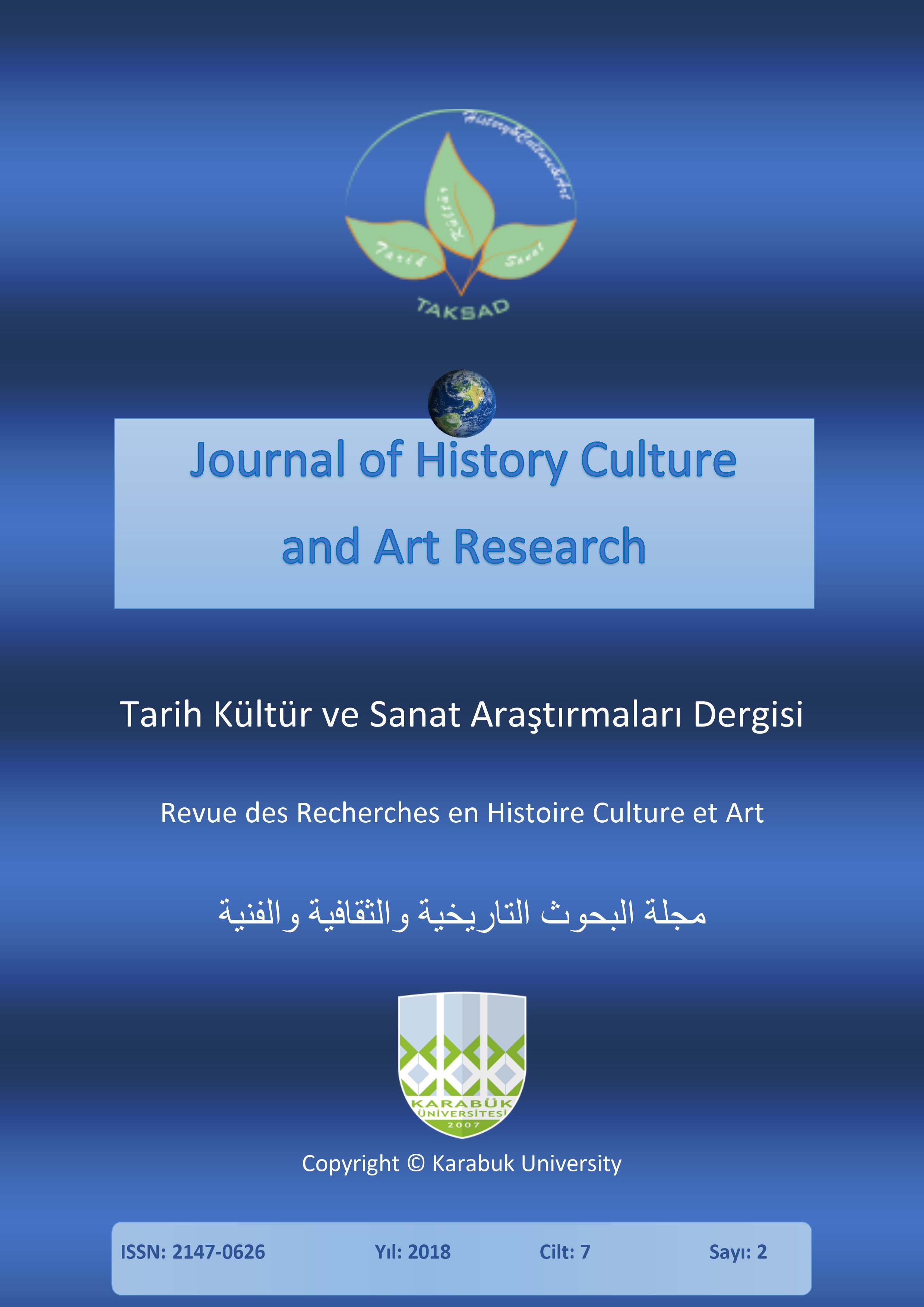Mimarlık Eğitiminde Peyzaj Tasarımı / Landscape Design in Architctural Education
DOI:
https://doi.org/10.7596/taksad.v7i2.1489Keywords:
Peyzaj, Peyzaj mimarlığı, Peyzaj mimarlığı eğitimi, İnterdisipliner eğitim, Peyzaj tasarımı, Landscape, Landscape architecture, Landscape architectural education, Interdisciplinary education, Landscape design.Abstract
Abstract
Collaboration among the professional disciplines has an important impact on the success of education and training. It is known that the architectural profession interacts with different professional disciplines at national and international universities that provide architectural education. These professions should be included in architectural education programs, especially because architecture is related to different disciplines such as civil engineering, interior architecture, landscape architecture, urban and regional planning. In this respect, design students studying in the field of architecture need to acquire interdisciplinary vocational education in order to develop their imagination, ability of thinking and to realize what they thinked.
In this context, a survey was conducted with 61 students from the 4th grade students who took the Landscape Design course in the Architecture Department of Avrasya University, which provides architectural education. The students who attended the lessons were asked for their opinions about whether the lessons contributing their professional quality or not. Survey questions were analyzed by SPSS Statistics 24 analysis program. The students who participated in the survey stated that the course was especially helpful when designing the site plan, determining the site elevations and building entry-exit points. In addition, students stated that they would like to take the landscape design course in 2nd grade instead of taking in the 4th grade.
Öz
Mesleki disiplinler arasındaki ortak çalışmalar, eğitim öğretimin başarısı üzerinde önemli bir etkiye sahiptir. Mimarlık eğitimi veren ulusal ve uluslararası üniversitelerde de mimarlık mesleğinin farklı meslek disiplinleri ile etkileşim içerisinde olduğu bilinmektedir. Özellikle Mimarlığın, İnşaat Mühendisliği, İç Mimarlık, Peyzaj Mimarlığı, Şehir Bölge Planlama gibi farklı disiplinler ile ilişkili olmasından dolayı, bu disiplinlere dair mesleki bilgiler eğitim programlarında yer almalıdır. Bu açıdan mimarlık alanında eğitim öğretim gören tasarım öğrencilerinin, düşünme, düşünüleni görme ve hayata geçirme adına hayal güçlerini geliştirmek için disiplinler arası mesleki eğitimi almaları gerekmektedir.
Bu bağlamda, bu çalışmada mimarlık eğitimi veren Avrasya Üniversitesi Mimarlık Bölümü, Peyzaj Tasarım dersini alan 4. Sınıf öğrencilerinden 61 kişi ile bir anket çalışması yapılmıştır. Dersi alan öğrencilerden ders kapsamında görüşleri istenmiş ve almış oldukları dersin, mesleki eğitimlerine katkısı olup olmadığı sorgulanmıştır. Anket soruları SPSS Statistics 24 analiz programı ile analiz edilmiştir. Ankete katılan öğrenciler dersin özellikle; vaziyet planı tasarlarken, arazi kotlarını ve bina giriş-çıkış noktalarını belirlerken yardımcı olduğunu ifade etmişlerdir. Ayrıca öğrenciler ankete vermiş oldukları cevaplarında 4. sınıfta almış oldukları Peyzaj Tasarım dersinin, eğitim öğretim yılları içerisinde 2. sınıfta almak istediklerini belirtmişlerdir.
References
Alangoya, K. A. (2015). “Tasarımcı Düşünce” Geleneğinin Maceracı Yapısı ve Kentsel Tasarım Eğitimine Katkısı Üzerine Deneysel Bir Kentsel Tasarım Stüdyosu: “İZ Üstünde Taksim Meydanı”, METU JFA, 32(1), 65-89.
Başer, B. (2010). Kentlerin Yüzyılının Kentsel Alt Evreni Olarak Peyzaj, Kent ve Peyzaj, Dosya, 18, 25-31
Bersin, J. (2004). The Blended Learning Book: Best Practices, Proven Methodologies and Lessons Learned, Pfeiffer and Co.
Bruns, D.; Ortacesme, V.; Stiles, R.; de Vries, J.; Holden, R. & Jorgensen, K. (2010). ECLAS Guidance on LandscapeArchitecture Education. The Tuning Project ECLAS- LE: NOTRE. Tuning Landscape Architecture Education in Europe, Report, Version 26, 58.
Devetakovic, R. M. (2007). Codification of Site Related Knowledge in Virtual Design Studios. In: Salama, A.M. and N.Wilkinson, N. (Eds), Design Studio Pedagogy, Horizons for the Future, 325-341.
Eckloo, G. (1969). The Landscape We See, Mc-Grow-Hill Book. Comp., New York.
Ergül, H. (2015). Mimarlığın İlham Edilen Sosyal ve Toplumsal Yönü, ISITES – 2015, İspanya, 1070-1079
Francis, M. (2001). A case study method for landscape architecture, Landscape Journal, 20(1), 15-29.
Gül, A. (2000). Peyzaj İnsan İlişkisi ve Peyzaj Mimarlığı, Süleyman Demirel Üniversitesi, Orman Fakültesi Dergisi, A (1), 97-114.
Güler, B. (2000). Mimari Doğa İlişkisi ve Doğayla Uyumlu Mimari Yaklaşımları Üzerine Bir İnceleme, Yüksek Lisans Tezi. İstanbul Teknik Üniversitesi. Fen Bilimleri Enstitüsü. İstanbul.
Hashimshony, R. & Haina, J. (2006). Designing the University of the Future. Planning for Higher Education, 34(2), 5-19.
Hudnut, J. (1934). Education of the Architect: Report of Dean Joseph Hudnut, Architectural Forum 52, no. 2, 166-168.
Joklova, V. & Pifko, H. (2015). Innovation in Architectural Education – OIKONET Experience, Global Journay of Engineering Education, 17(3), 124-131.
Keskin Samancı, N. & Özer Keskin, M. (2007). Felder ve Soloman Öğrenme Stili İndeksi: Türkçeye Uyarlanması ve Geçerlik-Güvenirlik Çalışması, Ahi Evran Üniversitesi Kırşehir Eğitim Fakültesi Dergisi (KEFAD), 8 (2), 37-54.
Kristianova, K.; Putrova, E. & Gecova, K. (2017). Landscape Architecture for Architects- Teaching Landscape Architecture in the Architecture and Urbanism Study Programmes, Global Journal of Engineering Education, 19-1, 60-65.
Kurt, S. (2009). An Analytic Study on the Traditional Studio Environments and the Use of the Constructivist Studio in the Architectural Design Education, Procedia Social and Behavioral Sciences 1, 401-408.
Oluwatayo, A. A.; Aderonmu, P. A. & Aduwo, E. B. (2015). Architectıre Students’ Perceptions of their Learning Environment and their Academic Performance, Learning Environment Research, 18, 129-142.
Onat, E. (1981). Mimari Tasarım Eğitiminin İlk Basamağında Kullanılabilecek Bir Yöntem, Doktora Tezi, Ankara Devlet Mühendislik ve Mimarlık Akademisi Mimarlık Fakültesi, Ankara.
Saghafi, M. R.; Franz, J. & Crowther, P. (2012). Perceptions of Physical versus Virtual Design Studio Education, Archnet-IJAR, 6(1), 6-22.
Yazar, T. (2009). Mimari Tasarım Stüdyolarında Sayısal Egzersizler. Doktora Tezi, Yıldız Teknik Üniversitesi, Fen Bilimleri Enstitüsü, İstanbul.
Yorgancıoğlu, D. (2011). Mimari Tasarım Eğitiminde Disiplinler Arası İşbirliğinin Önemi: Tarihsel Arkaplanın Yeniden İnşası, Mimari Tasarım Eğitiminde Bütünleşme II. Ulusal Sempozyumu, 1-10.
Downloads
Published
How to Cite
Issue
Section
License
All papers licensed under Creative Commons 4.0 CC-BY.- Share — copy and redistribute the material in any medium or format
- Adapt — remix, transform, and build upon the material for any purpose, even commercially.
Under the following terms:
Attribution — You must give appropriate credit, provide a link to the license, and indicate if changes were made. You may do so in any reasonable manner, but not in any way that suggests the licensor endorses you or your use.
- No additional restrictions — You may not apply legal terms or technological measures that legally restrict others from doing anything the license permits.







